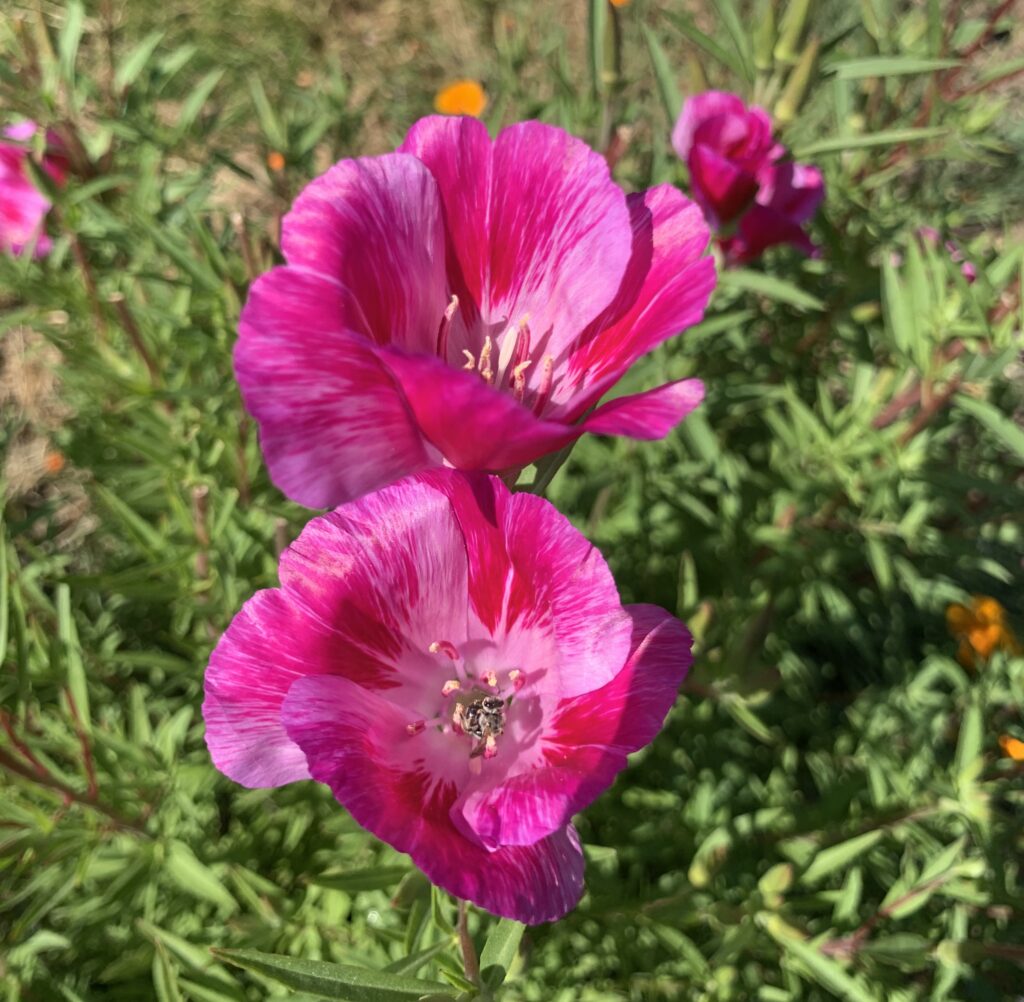A study of leafcutter bees and a PNW native flower, through the lens of iNaturalist.
The Clarkia Project team: Mallory Mead, Jen Hayes, Sarah Erskine, and Ali Filipovic
If you are a subscriber to our blog, you have likely seen our photos and videos of one of our favorite plant-pollinator interactions: the petals of Farewell-to-Spring (Clarkia amoena) being harvested by leafcutter bees!
After observing this eccentric harvest behavior in the research garden, we got curious about the bees behind the petal-nest craft, and how we could study this interaction further.


iNaturalist is a popular community-supported biodiversity database that the Garden Ecology Lab has been experimenting with in recent years. Jen realized that the leafcutter bees’ distinct crescent-shaped mark are visible in many iNaturalist observations of Clarkia amoena. She wondered how we could use the already sizeable iNaturalist database of Clarkia amoena observations to study the interaction over a wider geographic and chronological scale than that of the research garden. Jen and Gail agreed to mentor me in producing an undergraduate research thesis on this subject.
The study’s objective is to use iNaturalist’s data on Clarkia amoena to see if there is a difference in leafcutter bee usage of Clarkia amoena petals based on whether the flower is a native versus a cultivar type, and whether the flower is found in an urban or non-urban environment.
In this process we have found that iNaturalist is easy for anyone to contribute to, but the information it provides is limited compared to the wealth of contextual information gained when being in the actual, living presence of a specimen. So, to get a greater feel for the intricacies of this flower, I embarked on what we called “Ground-Truthing Field Trips” to check out some Clarkia amoena populations in the “real world”.
I went out during peak pollinator season, following the coordinates of recently posted iNaturalist observations. Each specimen I visited was incredibly different from the next. I found the delicate blossoms in natural areas, the borders of farmland, restoration sites, and gardens.
Data from these trips will not be published in my thesis because the contexts are not exactly comparable, and my sampling was exploratory rather than precise. Nonetheless, I gained contextual insight and inspiration watching diverse pollinator assemblages in beautiful meadows of pink.

The field trips have helped us more clearly see through the window of iNaturalist and have informed the methodology we use.
For example, I saw examples of hybridization between two species of Clarkia in a seeded restoration site, and cultivar-hybrid escapees in natural areas. It’s been important to navigate identification of cultivars and hybrids in iNaturalist.


In a restoration prairie seeded with two different Clarkia species, pollinators cross-pollinate them, giving rise to sterile hybrids (Lewis & Raven, 1958). Note the malformed stigma and anthers.
Simultaneously, our field crew recorded petal-cutting behavior on the Clarkia amoena natives and nativars at Jen’s research garden this summer. Below are the three cultivars in the garden, and if you look closely you can see “petal-cuts” which we counted and recorded weekly. We will analyze the difference in leafcutter usage between the cultivars and native type.




Clarkia amoena is an annual that reseeds itself effectively, so last year’s seeds gave rise to this season’s blooms. To our surprise, however, Clarkia amoena of all different colors started popping up in our research plots this Spring! Last season’s bees had combined pollen from the garden’s varieties bringing rise to all sorts of intermediate forms.
Clarkia amoena is prone to hybridization between members of the species or cultivars in the same proximity. These intraspecific hybrids are fertile. We seek to explore how cultivar genetics may be moving into natural populations.
Through the winter, our team is working with the iNaturalist data to quantify leafcutter bee petal usage. We expect to share our results in June 2023, so stick around to hear about our findings!
Work Cited:
Lewis, H., & Raven, P. H. (1958). Rapid Evolution in Clarkia. Society for the Study of Evolution, 12(3), 319–336.
